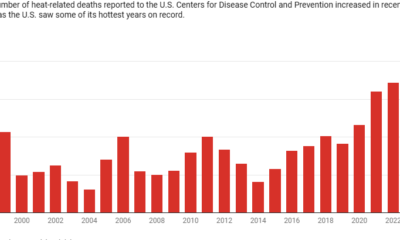environment
Surviving Arizona’s Monsoon: Essential Tips for Asthma Sufferers to Breathe Easy

A potent dust and rain storm swept across Arizona this past weekend, intensifying the state’s ongoing monsoon season. While many anticipate the cooling effect of these summer storms, asthmatics brace for potential health challenges.
The Arizona monsoon season, spanning from June to September, is notorious for its heavy thunderstorms. These storms create a “perfect recipe” of conditions harmful to those with asthma, explained Dr. Janna Assar, a family medicine physician at Banner Health. Thunderstorms rupture large pollen grains into smaller, inhalable particles, triggering asthma attacks.
Statistics from the Center for the Future of Arizona indicate that around 10% of Arizonans suffer from asthma. This chronic respiratory condition inflames airways, making breathing difficult. Dust, pollen, and other allergens in the air exacerbate these flare-ups.
Dust storms, or haboobs, further complicate the issue for asthmatics. Generated by strong downdrafts, these storms lift dirt and sand into the air, creating walls of dust. “If rain doesn’t follow a dust storm, the lingering dust becomes a persistent irritant,” noted Erinanne Saffell, Arizona’s state climatologist.
These dust storms often carry additional particulates like mold and pollen. “Breathing in such dust, laden with pollens and possibly mold or fungi, can severely aggravate asthma,” said Barbara Burkholder, a public health consultant and Massachusetts Department of Public Health board member.
Avoiding outdoor exposure during dust storms is critical for asthmatics. However, for some, staying indoors isn’t always an option. “When it’s hard to breathe, it’s hard to go to work,” shared Amy Singley, an asthma patient of over 30 years.
Studies suggest that caffeine may provide temporary relief, while switching to stronger medications during the monsoon can manage symptoms more effectively. “I went from one level of asthma medicine to another,” Singley mentioned, adding that she continues to use stronger medication beyond monsoon season.
Dr. Assar advocates for patients to switch to a preventive steroid inhaler during monsoon season, emphasizing better daily management. “Using a preventive inhaler can keep asthma well-controlled and prevent severe monsoon-induced attacks,” she advised.
In case of sudden dust storms, Dr. Assar recommends quickly seeking indoor shelter and staying put until the storm passes. Experts also suggest keeping an asthma action plan, carrying an inhaler at all times, regularly cleaning vents, and using air purifiers to mitigate indoor air pollution.


















